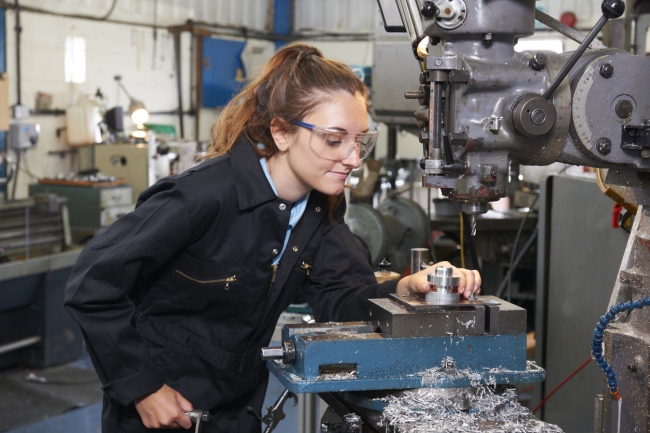4 minute read • published in partnership with Barclays
Opinion: Women in manufacturing – start at school, make it more fun and play the long game
Each year the figures are published, notably from Engineering UK but also from bodies including the IET, WISE, WES, MAKE UK and others: the gap in the demand for and supply of qualified engineers is very big. In the 2018 Engineering UK report it was over 20,000 vacancies. Core STEM skills shortages are costing UK business £1.5bn per year, according to a recent survey of employers reported by WISE.
Lee Collinson from Barclays highlights that to attract more women into the manufacturing sector, a long term, cultural grassroots solution from industry is required.
Scan the internet and you will find many articles, reports and blogs about encouraging women to work in manufacturing and engineering. The logical solution to the skills crisis: match the big shortfall in engineers with the biggest available demographic – women.
But, despite some success in recent years, the challenge is very tough. Girls – going back to school age – are statistically good at science subjects at GCSE, with girls getting better GCSE grades in these subjects, while boys edge girls at maths in some years. But post-GCSE, it falls apart. The percentages of girls that choose STEM A-levels, STEM diplomas and STEM apprenticeships, all nosedive after GCSEs.
At GCSE there is an equal gender balance for the sciences and maths, but for maths and physics A-levels, girls make up 39% and 22% of students in those subjects respectively. Computing A-level is made up of just 12% female students. And these figures have improved since the mid 2010s.
Whatever is happening, the results are borne out. Low numbers of female STEM A-level students converts to fewer core STEM graduates.

The percentages of girls that choose STEM A-levels, STEM diplomas and STEM apprenticeships, all nosedive after GCSEs / Picture: Getty/iStock
Apprenticeships are also under-represented by female applicants. In 2017/8, just 12% of Information and Communication Technology (ICT) apprenticeships were completed by females, continuing a trend of year-on-year decline since 2014/5. The percentage of engineering and manufacturing technologies apprenticeships completed by women has remained steady at 7% every year from 2014/15 to 2017/18. Where there is a very small increase for girls taking STEM apprenticeships, it is for the Higher-level apprenticeships, a positive trend because the greatest skills shortages in core STEM are at higher skills levels.
While the numbers are cause for dismay, they have improved. WISE says in 2011 the proportion of women in the engineering workforce was just 6%, and their figures show the number of women working in STEM careers (inc engineering) rose by more than 60,000 between 2016 and 2017.
Taking action
Faced with the clear need to get more women into manufacturing, what are companies doing about it?
Galvanised by International Women in Engineering Day in June 2018, Network Rail aimed to increase the proportion of female employees. The aim of the International Day or IWED is to encourage more companies and organisations to run their own outreach events. Network Rail already had an early engagement programme for schools. It also supported Girlguiding’s pro-engineering efforts. The rail operator has worked with consultancy Amey to provide information for a Girlguiding award that teaches girls about civil engineering, including the railways and train stations.
Network Rail’s outreach work for female engineers has worked, as more women have applied for jobs and been employed by the company in recent years. An important change applied was a new approach to the language and messaging used in promoting jobs, where any “unconscious bias” in the wording to appeal mor to men, or the choice of channel or publication, were identified and changed to be gender neutral. These apparently small changes had a measurable effect.
Birmingham City University student Ria Rana, 19, won a £1,000 scholarship from Nottinghamshire-based Meridian Lightweight Technologies UK (MLTUK), the world’s biggest producer of magnesium component parts. She will also receive work experience at MLTUK, after entering a competition that invited students to write an article outlining the importance of magnesium for the future. Entrants were then interviewed about their vision for magnesium use by an expert panel. The competition was aimed at getting more women in the region into science and engineering based professions.

Figures show the number of women working in STEM careers (inc engineering) rose by more than 60,000 between 2016 and 2017 / Picture: Getty/iStock
Siemens
Siemens has set a target for 20% female apprentices by 2020. Its activities include running the SeeWomen careers roadshow (see link), schools presentations, targeted recruitment focused on areas of its business with the lowest female representation, and raising the profile of its female apprentices.
One young Siemens employee Helen Brindley struggled to reach the A-Level physics grades that the normal apprentice pathway demanded. But she had great experience; inspired by her aeronautical engineer brother, by Year 10 Helen was learning CAD at a local company and repairing robots on placement at Jaguar LandRover. She was encouraged to join an apprenticeship scheme at the Siemens Finance and Commercial Academy.
She told the MAKE UK awards, where she was runner up in the North West for the first year higher apprentice of the year award, “I was lucky that Siemens look for passion and a willingness to learn, meaning my less-than-perfect A-Level physics score didn’t hold me back.” Helen is now a second year Higher Engineering Apprentice DF PD at Siemens in Stockport.
While companies like Siemens and GlaxoSmithKline, the latter that sponsored the Top 50 Women in Engineering awards in 2019, can afford to actively recruit and target more women, it is smaller companies that need the gender diversity as much but don’t have the recruitment resources.
There are some anecdotal stories like MLTUK above, recruiting women via competitions. But SMEs still suffer the same problem recruiting and retaining girls as boys; visibility, attractiveness and perceptions about the whole package being inferior to large companies.
What’s clear is with the numbers of women taking post-GCSE STEM qualifications low and remaining fairly low over time, this requires a long term, cultural grassroots solution and industry can’t expect women to fill the STEM jobs gap in the next few years.
